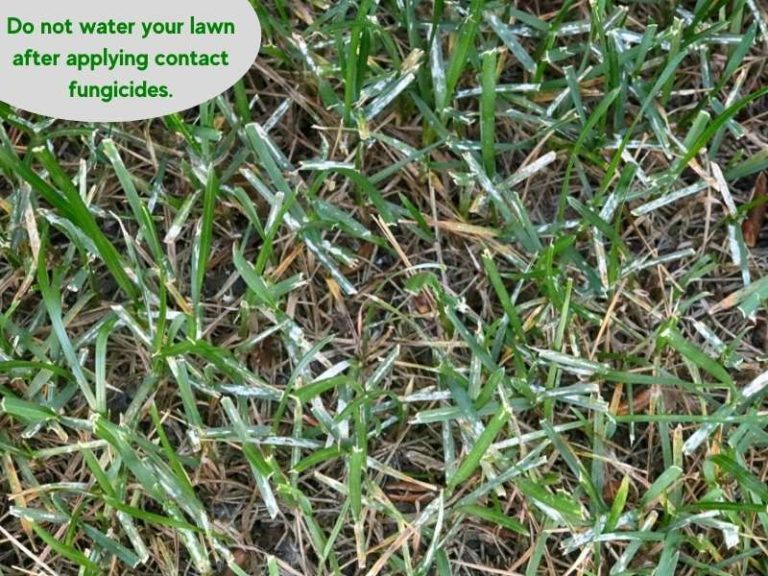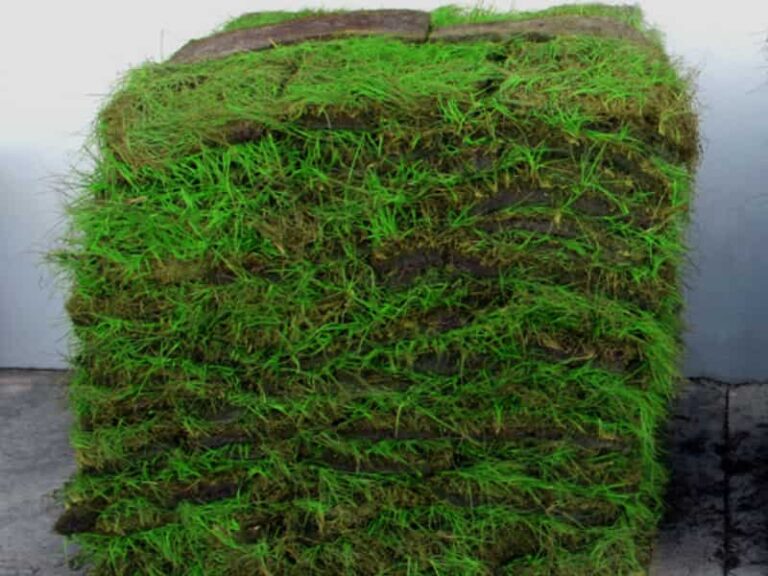Dead Patches on Lawn (Causes and Fixes)
It’s not uncommon to spot brown unsightly patches on your lawn. While these patches are sometimes seasonal, and the brown spots green up after a while, a dead patch on your yard should always be cause for concern.
Dead patches on the lawn can be mistaken for seasonal dormancy. However, this problem is more serious and is caused by various factors, brown patch disease being the most common. To fix dead patches on your lawn, reseed or resod the affected spots after treating the underlying cause.
Contents
Signs of Dead Grass
Brown patches of grass on your lawn could mean that the grass is either dead or dormant, and you need to know how to differentiate between the two. Dead grass can’t be revived, and the surest way to determine that the patch of brown grass on your turf is dead is by pulling some of it with your hand. If it comes out easily without any resistance, dry roots, and brittle from leaves down to the base of the crown, it’s dead grass.
Also, turfgrass tends to die out in patches. If the whole lawn is brown, the turf is probably dormant. However, if parts of the lawn are still green, but there are round spots of brown grass, these spots are likely dead.
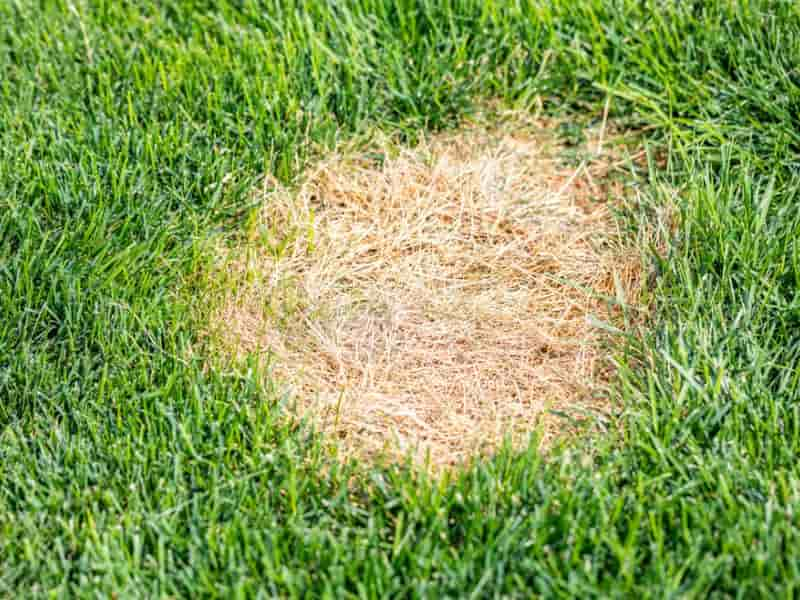
Other signs of dead or dying grass include:
- The grass doesn’t spring back to life even after you water the lawn, and the water beads up on the surface of the lawn.
- The brown spots feel spongy when you walk on them.
- The grass wilts in the sun.
What Causes Dead Patches on Grass Lawns
Several factors can kill turfgrass and cause brown spots on the lawn. The most common causes of dead patches on grass lawns include:
- Brown patch disease
- Thatch
- Excessive fertilizer
- Improper lawn practices like mowing and watering
- Grubs
- Pet urine
- Poor soil quality
Brown patch disease
Brown, circular patches of grass can be a sign of brown patch disease caused by the Rhizoctonia fungus. A smoke ring border usually surrounds the dead, brown grass. Brown patch disease typically occurs during high heat and humidity seasons, as these conditions are conducive for Rhizoctonia fungi.
Thatch Buildup
Thatch is a layer of dead, decaying organic matter that settles between the grass blades and the roots. Whenever the thatch layer in the lawn builds up over ½-inches thick, it chokes the grass by cutting out the supply of air, water, and nutrients. With the grassroots deprived of crucial nutrients, water, and air, the turfgrass dries out and dies, resulting in dead patches on your lawn.
Excessive fertilizer
Fertilizer burn occurs when you apply excessive fertilizer or inadvertently spill fertilizer on your lawn. The fertilizer directly burns the grass blades, while the nitrogen overload in the soil damages the grass roots, causing the grass to turn brown and die off.
Improper Lawn Practices (Mowing and Watering)
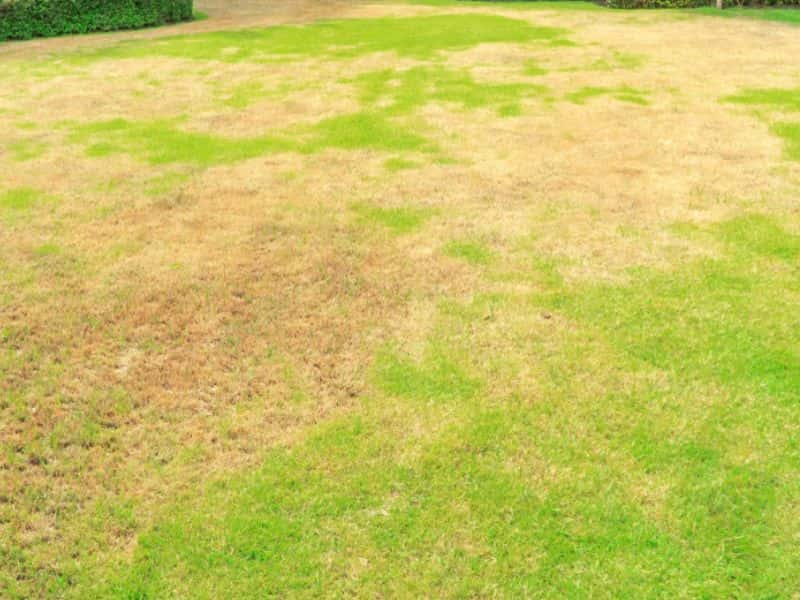
- Poor and incorrect mowing practices, such as mowing too low (scalping) and using a mower with dull blades, can damage turfgrass and cause it to die off.
- Inconsistent and inadequate watering practices can lead to dead patches on your grass. Underwatering deprives the lawn of one of the necessary resources (moisture) to thrive. On the other hand, overwatering causes soggy lawns suffocating the root and causing it to rot and decay.
Grubs and Other Pest Infestation
Grubs and other lawn insect pests can cause turfgrass to turn brown and die. These larval pests feed on grass roots, causing havoc on your lawn and leaving behind nothing to hold the grass in place. As a result, the grass shoots turn brown and die. Grub-infested grass also comes out easily when tugged due to the lack of roots. Other insect pests that can kill grass include chinch bugs, mites, and nematodes.
Pet Urine
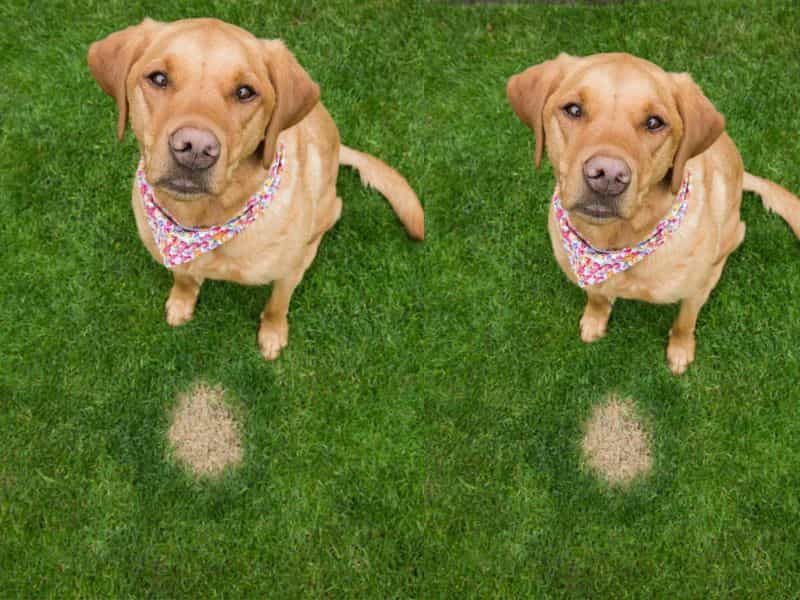
Does pet urine kill grass? Urine from pets like cats and dogs can also cause the grass to turn brown and die off. Animal urine contains high concentrations of urea, which burns the grass. You can identify brown patches caused by pet urine by the bright green rings formed around the patches. These rings are usually a result of the diluted nitrogen from the urine, which acts as a fertilizer.
See Also: Does human urine kill grass?
Poor Soil Quality
Is your area prone to soil erosion? When was the last time you took a soil test? Poor soil quality may result from soil erosion (flooding or heavy rain) or inadequate soil nutrients due to overfarming, recent build-up, draught, or water shortages can affect your lush lawn and leave behind a trail of brown dead spots.
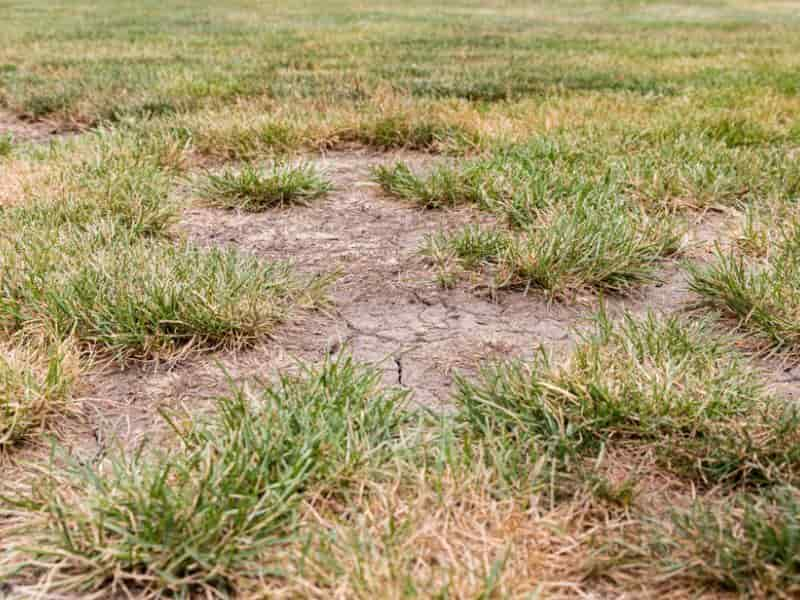
Soil texture determines its ability to support your grass growth. Poor draining soil, low fertility, sandy and compact are characteristics of poor soil quality. Soil erosion aggravates this problem even when one tries to fix it by top-dressing or adding beneficial organic matter.
How to Fix Dead Spots in Lawns
For successful lawn patch repair, you must first know the cause of the dead spots, as each causative factor requires a different treatment. Here’s how to properly treat browning lawns:
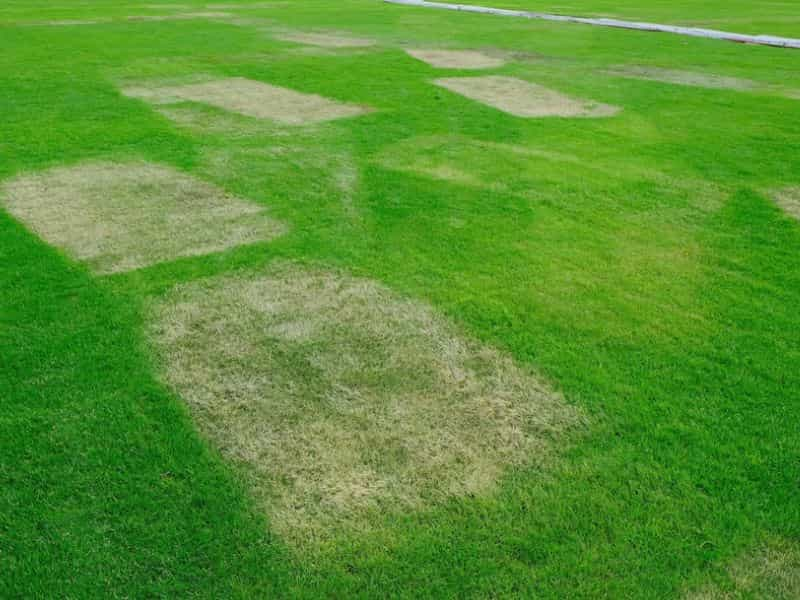
Apply a Fungicide
For dead grass spots caused by fungal disease, apply a chemical fungicide to kill the fungal organisms causing the brown patch disease. Afterward, ensure the fungi don’t infest your turf again, making the environment inconducive. Regularly inspecting your lawn for signs of pests and promptly taking appropriate measures, such as applying insecticides or using organic pest control methods, can help prevent these destructive infestations.
Prevention entails aerating and dethatching to reduce humidity and watering at the right time of the day so that the grass dries out before nightfall. Meanwhile, for browning caused by pests like grubs, use an insecticide to eradicate the infestation.
Adopt Proper Lawn Care Maintainance
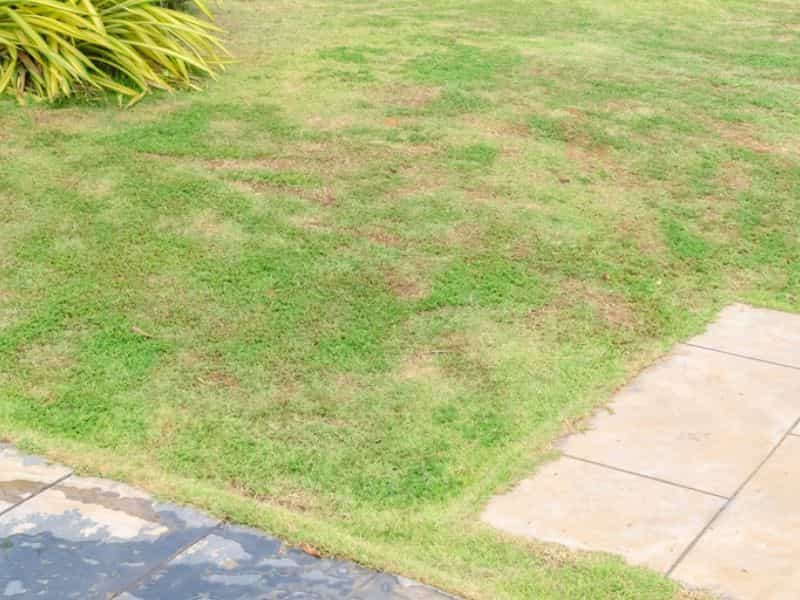
- Adopting proper mowing techniques, such as maintaining an appropriate grass height and using sharp blades, can prevent the weakening of the grass blades and make them less susceptible to stress and disease.
- Properly irrigating your lawn will help provide adequate moisture for a lush, thriving lawn. You must find the right balance (avoid insufficient watering and underwatering) for proper irrigation to prevent parched dead patches from appearing on your lawn.
Dethatch the Lawn
Dethatching allows the lawn to breathe by removing the layer of thatch that’s smothering your grass to death. Use a dethatching rake to break up the thatch layer so that water, air, and nutrients can pass through to the soil and the grassroots.
Leach Out Excess Fertilizer.
If the dead patches are due to excessive fertilizer, leach the fertilizer out of the ground by water using a garden hose or a sprinkler system. Avoid fertilizing your lawn with excess nitrogen or when it’s hot and humid. Always seek advice from the store to select a fertilizer with a suitable NPK value.
Aerate and Add Organic Matter
Poor soil quality (compact, nutrient deficient) weakens the grass root system, leaving the lawn prone to insects and disease. Aerate your lawn and consider adding organic matter to combat soil erosion, improving soil quality. You can improve soil like clay to establish a thriving lawn.
The soil pH levels need to be optimal for your grass. Aerating can help amend the soil but still consider testing your soil to avoid trial and error measures that won’t address the underlying causes of an unhealthy lawn.
Reseed the Lawn
Reseeding your lawn or resodding the dead patches of your grass is the final and most important step in lawn repair for brown, dead grass. The surrounding grass will spread and fill in the bare spots for smaller brown patches after you apply the fixes detailed above. However, the dead grass won’t come back for larger areas if you only treat the underlying causes without reseeding.
Rake off the dead, dry grass to expose the soil and add some topsoil. Then, sprinkle new grass seeds at a rate of about 20 for every square inch of lawn area. Finally, water the lawn so the soil mix settles and germination begins.
Here is a video guide to reseed bare spots on your lawn
FAQs
Is dry grass dead?
Dry grass could be dead, or it could just be dormant. Dormant grass appears dry and brown above the soil surface, but the roots remain healthy.
Will watering dead grass bring it back?
Dead grass cannot be brought back to life by watering, as the root system is already damaged. The only solution is to reseed or resod the dead patches.
Why is my grass dying in winter?
Winter kill is commonly caused by crown hydration, desiccation, and ice sheets. Voles, a type of rodent, can also cause your turfgrass to die off during winter.
Will dead spots in the grass grow back?
Dead grass can’t spring back to life, and the only way to revive your lawn, if this occurs, is by planting new grass seed.
How do you cure dead grass?
You can’t cure dead grass unless the turf only appears dead due to dormancy. Dormant grass can be cured by watering.
What is the fastest way to remove dead grass?
The fastest way to remove dead grass is by dethatching. Use a rake or a dethatcher to dethatch your lawn properly.
What kind of fungicide to use on the lawn for brown patch?
The best fungicides for lawn with brown patch includes Fluoxastrobin, Azoxystrobin (with propiconazole), and Azoxystrobin (with propiconazole). In addition, these fungicides prevent other fungal diseases like large patches and other fungi like blights, mildews, molds, and rust. You can get Strobe Pro G Granular Fungicide, Pillar G Intrinsic Fungicide, or Fame Granular Fungicide to best deal with the brown patches problem on your lawn.
Will grass fill in bare spots on its own
No, most grasses will not fill the bare spots on their own. They need reseeding or resodding. However, some grass types, like Kentucky bluegrass, have runners that help spread independently. Add a few inches of compost and seeds in a bucket, gently rake the spot and evenly pour your mixture and rake lightly to fill the bare spots on the lawn.
Will lawn fungus go away on its own?
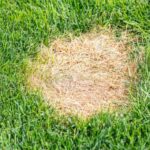
No, the fungus doesn’t go away on its own it needs proper treatment, either with fungicides or with natural methods; you must have patience until it clears out. However, proper care and maintenance, like appropriate mowing, watering, and correct fertilizer application, can help accelerate healing from fungal infections.
Tips to Prevent and Fix Dead Spots in Lawns
- Water your lawn early, before 10 a.m. or between 4 p.m. and 6 p.m.
- Fertilize carefully to avoid excess nitrogen or overfertilization.
- Aerating and dethatching to improve air circulation in your soil and prevent starving your grass lawn of essential resources (water & nutrients).
- It’s best to seek professional advice on fungicides or leave spaying to professionals.
- You can consider getting Lawn Soil to improve your lawn soil profile.
- Take regular inspections on your lawn for signs of pest infestation and take appropriate measures to prevent further lawn damage.
Final thoughts
Understanding the causes and signs of dead patches on your grass lawn can help you proactively address and prevent it. If you have brown grass spots on your lawn and the grass comes out easily, the grass is dead/dying.
Implementing proper watering techniques, practicing appropriate mowing and lawn care methods, and being vigilant against pests and diseases are key to maintaining a vibrant and healthy lush lawn. Apply the appropriate treatment to fix the underlying cause and reseed to revive the dead patches on the lawn. Take note that dead grass is not the same as dormant grass.
References
I. Diana Alfuth, The University of Wisconsin (Madison) Horticulture Extension Program: Now is a great time to fix dead spots in lawns.

